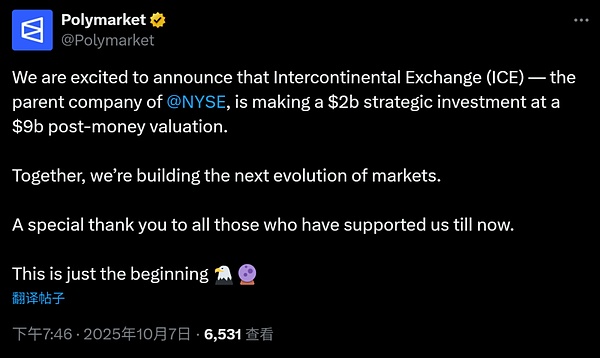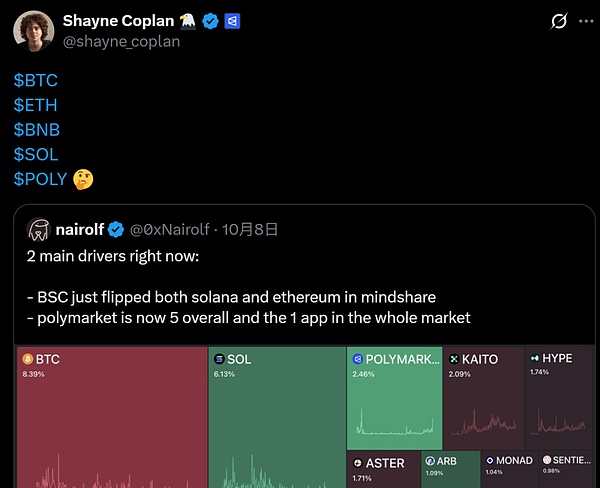The "prediction market" breaks through the circle: ICE enters the market, Hyperliquid increases its investment, why are the giants competing for "pricing uncertainty"?
When was the last time you heard of a billion-dollar funding round for Web3?
On October 7, 2025, the prediction market Polymarket officially announced that the Intercontinental Exchange (ICE), the parent company of the New York Stock Exchange, would make a strategic investment of US$2 billion in it, with a post-investment valuation of up to US$9 billion. This is not only one of the highest financing amounts obtained by a Web3 project in recent years, but also pushes the potential and popularity of the prediction market to the center of the stage.
Interestingly, the competition has been accelerating visibly in recent times, whether it’s decentralized players like Hyperliquid joining the fray or compliant latecomers like Kalshi accelerating their efforts to catch up.
Behind this, it is not only about who will dominate the future prediction market, but also about how to financialize all uncertainties in the real world.

From Polymarket to Kalshi, multiple blossoms
Decentralized prediction markets have always been one of the important practical tracks for early blockchain applications. For example, I frequently saw examples of old players such as Augur in many popular science books many years ago. Whether it is elections, weather, inflation, sports or IPOs, users can directly trade "yes/no" contracts on a decentralized platform.
But in fact, although the concept was proposed early, it was not until the emergence of Polymarket that the concept was truly broken out of the circle, and this was largely inseparable from the boost from the 2024 US presidential election:
Against the backdrop of traditional polls generally favoring one side, Polymarket ultimately demonstrated, with its accurate predictions and verifiable price signals that surpassed polls, that this decentralized prediction market, which uses "real money" to vote, has extremely high reference value for observing market trends.
This has also led to Polymarket becoming a frequent probability reference source cited by mainstream media in different events in the past six months. However, the prediction market has been struggling with the shackles of compliance. For example, in 2022, Polymarket was fined $1.4 million by the U.S. Commodity Futures Trading Commission (CFTC) for operating an unregistered derivatives market and was banned from providing services to U.S. users.
In the past two years, Kalshi, which was established earlier than Polymarket, has emerged as a dark horse and chosen a path focused on compliance - becoming the first prediction market platform regulated by the U.S. Commodity Futures Trading Commission (CFTC). In October 2024, a federal court also ruled that it was allowed to launch the first regulated election market in the United States, which also made Kalshi's regulatory position more solid.

Source: polymarketanalytics
As of October 10, 2025, a comparison of Polymarket and Kalshi data shows that, in addition to the total trading volume of Polymarket being $1.3 billion vs $410 million, which is a significant lead, Polymarket has fallen behind Kalshi in terms of the number of markets (10,200 vs 43,500) and open interest (US$170 million vs US$240 million).
It is worth noting that in order to return to the US market, Polymarket actually adopted a compliance grafting strategy this year: as early as July, it acquired QCX LLC, a trading platform holding a CFTC license, for US$112 million and has begun self-certification of event contracts including sports events and election markets.
This is also likely a combination of the latest $2 billion in financing, and Polymarket CEO Shayne Coplan also posted a tweet with the POLY symbol on October 9, which may become a key variable in the competition between the two giants.

From prediction markets to larger parent sets
Many people may be curious about why ICE, the parent company of the New York Stock Exchange, made a huge bet of $2 billion on Polymarket?
This requires going beyond Web3 and understanding the prediction market from a larger financial perspective.
First of all, ICE has been actively deploying in the Crypto field, including deploying crypto financial products through its parent company and multiple affiliated entities over the years, gradually covering targets such as Bitcoin spot and futures contracts, as well as the well-known crypto trading platform Bakkt.
Secondly, the prediction market is essentially a subset of the "trading platform", or another form of presentation. For example, Polymarket has many price prediction bets for mainstream crypto assets such as BTC and ETH at different time points such as the end of October and the end of the year.
Theoretically, if the time nodes for predicting fulfillment are infinitely subdivided, from the end of the year to the end of today, to 1 minute later, and 1 second later, then this essentially becomes an instant "bet" (buying and selling behavior) on the trading platform. Perhaps what ICE values is this ability to financialize all uncertainties, which can expand the boundaries of existing derivatives markets such as futures and options.
Therefore, platforms like Polymarket, with their vast user base and trading volume, can serve as a key entry point for ICE Group's future structured financial products, institutional hedging tools, and information pricing services. In other words, ICE isn't focused on a single application, but rather on the potential of the prediction market to "derivative everything"—the uncertainty.
For this reason, in addition to the competition between Polymarket and Kalshi, which is more like a specialized path for event markets, decentralized players such as Hyperliquid have also begun to explore a hybrid path of inserting prediction modules at the entrance of high-performance contract platforms. Both paths have their own advantages and disadvantages, but they may also complement or compete with each other in the future.
New variables for decentralized players like Hyperliquid
For example, the HIP-3 proposal passed by Hyperliquid introduced a permissionless, developer-deployed perpetual contract market on the core infrastructure. Previously, only the core team could list trading pairs, but now any user who pledges 1 million HYPE can deploy their own market directly on the chain.
In short, HIP-3 allows the permissionless creation and listing of derivatives markets for any asset on Hyperliquid, which completely breaks the limitation that Perp DEX could only trade mainstream cryptocurrencies in the past.
This not only means an open contract deployment mechanism, but also lays the technical foundation for subsequent prediction market modules. In the future, users on Hyperliquid may be able to directly trade such markets:
- Will the Fed cut interest rates at its next meeting?
- "Will BTC break through $70,000 this week?"
- "Will Arbitrum TVL exceed Base at the end of the month?"
Under this architecture, the prediction market is no longer an independent track, but a sub-module in the on-chain high-performance derivatives system. And because it reuses Hyperliquid's matching depth, clearing system and order book logic, it naturally has higher transaction efficiency and capital utilization.
In comparison, Polymarket's model is more inclined towards "event trading" and Hyperliquid's model is more inclined towards "price trading" - one starts from information and the other starts from structure, but both point to the same end: allowing future probabilities to be priced instantly by the market.
Final Thoughts
Overall, with the involvement of heavyweight decentralized players like Hyperliquid and ICE’s $2 billion investment, the prediction market is no longer just a tool for people to “bet” or “predict the future”, but has become a frontier for institutions, analysts, and even central banks to observe market sentiment.
This also means that it is no longer just a paradise for speculators, but is rapidly transforming into a highly efficient and highly liquid financial derivatives market, becoming an indispensable financial primitive in the DeFi infrastructure.
You May Also Like

Huang Licheng's two positions have increased to $10.92 million.

US SEC approves options tied to Grayscale Digital Large Cap Fund and Cboe Bitcoin US ETF Index
